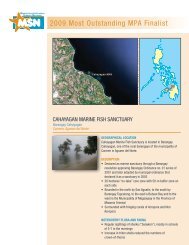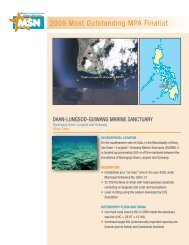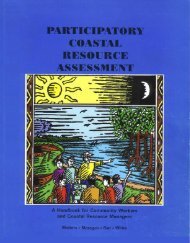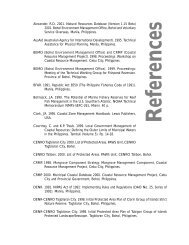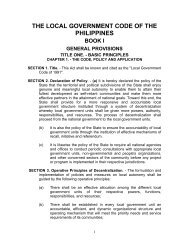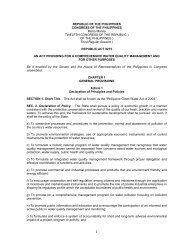Effectiveness of Marine Protected Areas in the Philippines for ...
Effectiveness of Marine Protected Areas in the Philippines for ...
Effectiveness of Marine Protected Areas in the Philippines for ...
You also want an ePaper? Increase the reach of your titles
YUMPU automatically turns print PDFs into web optimized ePapers that Google loves.
6 <strong>Effectiveness</strong> <strong>of</strong> <strong>Mar<strong>in</strong>e</strong> <strong>Protected</strong> <strong>Areas</strong><br />
Table 1. Representation <strong>of</strong> mar<strong>in</strong>e bioregions with<strong>in</strong> Philipp<strong>in</strong>e mar<strong>in</strong>e protected areas (MPAs).<br />
Number<br />
MPA coverage (km 2 )<br />
Municipal waters b<br />
protected (%)<br />
<strong>Mar<strong>in</strong>e</strong> bioregion a <strong>of</strong> MPAs all no take all no take<br />
Celebes Sea 50 2345.13 7.37 6.77 0.02<br />
Nor<strong>the</strong>rn Philipp<strong>in</strong>e Sea 35 2469.60 7.54 6.52 0.02<br />
South Ch<strong>in</strong>a Sea 51 1836.93 283.71 4.26 0.66<br />
Sou<strong>the</strong>rn Philipp<strong>in</strong>e Sea 102 3500.02 33.16 12.67 0.12<br />
Sulu Sea 90 3573.35 991.29 4.52 1.25<br />
Visayan Sea 663 1219.50 136.50 1.50 0.17<br />
a <strong>Mar<strong>in</strong>e</strong> bioregions taken from Ong et. al. (2002).<br />
b Municipal water boundaries (15 km <strong>of</strong>fshore) were calculated follow<strong>in</strong>g DENR (2001).<br />
Tablas Triangle had 1.24% <strong>of</strong> its area <strong>in</strong>side no-take<br />
MPAs.<br />
<strong>Mar<strong>in</strong>e</strong> protected areas represented priority areas <strong>for</strong><br />
mar<strong>in</strong>e conservation better than expected if <strong>the</strong>y were<br />
placed randomly (t test, t =−5.2797, df=99, p < 0.001).<br />
More than 50% <strong>of</strong> total MPA area and 70% <strong>of</strong> total no-take<br />
area was with<strong>in</strong> extremely high priority regions. This<br />
result was due, however, to <strong>the</strong> location <strong>of</strong> <strong>the</strong> largest<br />
no-take area <strong>in</strong> <strong>the</strong> Philipp<strong>in</strong>es (Tubbataha Reef MPA)<br />
be<strong>in</strong>g <strong>in</strong> an extremely high priority region.<br />
Size and Spac<strong>in</strong>g <strong>of</strong> Individual MPAs<br />
The size <strong>of</strong> MPAs ranged from 0.01 km 2 to 2789.14 km 2<br />
(Siargao <strong>Protected</strong> Landscape and Seascape, Fig. 1) (mean<br />
23.60 km 2 and median 0.15 km 2 , n = 604) (Fig. 3).<br />
The no-take area <strong>of</strong> MPAs ranged from 0.01 km 2 to<br />
968.28 km 2 (mean 2.48 km 2 and median 0.12 km 2 , n =<br />
571). The substantial difference between mean and median<br />
no-take area was due to <strong>the</strong> disproportionate contribution<br />
<strong>of</strong> <strong>the</strong> two largest no-take MPAs, Tubbataha Reef<br />
National Park (968.28 km 2 ) and Apo Reef Natural Park<br />
(274.69 km 2 ) (Fig. 1). These two MPAs have >85% <strong>of</strong><br />
<strong>the</strong> total extent <strong>of</strong> no-take area <strong>in</strong> <strong>the</strong> Philipp<strong>in</strong>es. N<strong>in</strong>ety<br />
percent <strong>of</strong> all MPAs <strong>for</strong> which spatial data were available<br />
had a total area <strong>of</strong>



